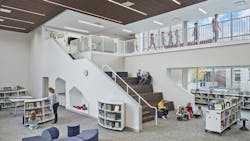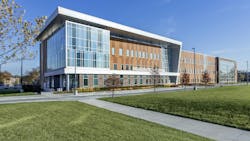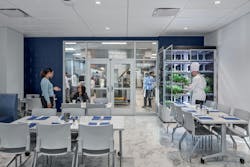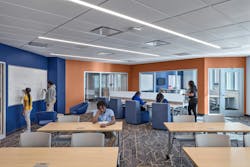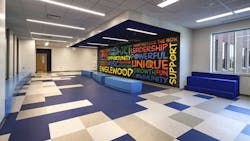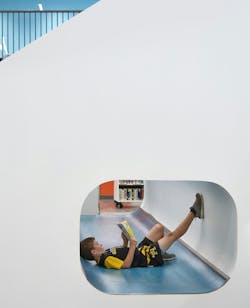Moody Nolan Shares School Initiatives that Serve Student Health
In 2022, roughly 56 percent of public schools moderately or strongly agreed that they could effectively provide mental health services to all students in need, emphasizing the pressing need for enhanced resources and strategies to address student well-being in educational settings. As education leaders increasingly rethink their school systems to prioritize the success of their student body, 60 percent of public schools have shifted to utilizing a “community school” or “wraparound services model.”
The wraparound service design approach in K–12 schools is a holistic strategy that aims to address the diverse and complex needs of students by integrating educational, social, and community resources. This strategy recognizes that academic success is deeply intertwined with social, emotional, and physical well-being. By providing comprehensive support services, wraparound services strive to create a nurturing and supportive environment that promotes student success both in and out of the classroom.
The core of a successful wraparound approach relies on the collaboration between schools, families, and community agencies. Schools work closely with social workers, mental health professionals, healthcare providers, and community organizations to create individualized plans that address the unique needs of each student. These plans often include academic support, counseling, health services, and family engagement activities that provide valuable insight into the evolving needs of the student body a project serves. By coordinating these services, schools aim to remove barriers to learning and ensure that students have the necessary support to thrive.
Addressing Health Disparities and Community Needs
Recognizing and addressing the impact of accessible healthcare on students establishes education environments as support centers. For example, a Moody Nolan K–12 project, Metro Early College High School in Columbus, Ohio, is working with Nationwide Children’s Hospital to provide integrated health services for the new school, ensuring that students and the community have direct access to essential healthcare resources that they may not have otherwise. This partnership will lead to a fully operational community health clinic by January 2025.
Outside of Ohio, this approach has been implemented in Moody Nolan’s other education projects including Detroit, Chicago, and Seattle school districts. For instance, Englewood STEM High School on Chicago’s South Side features an on-site medical center to provide health and wellness support to not just students but the wider community. As an active symbol of community investment, the contemporary facility addresses Englewood’s education and health disparities through its thoughtful, outward-facing design and integration of community resources.
In addition to health services, a key component of the wraparound approach is its incorporation of trauma-informed design principles specifically for disadvantaged communities. This extends to providing essential resources like food pantries and hygiene services that have a broader impact on the surrounding area and support students’ basic needs.
Encouraging College and Career Readiness
This holistic strategy addresses all forms of students’ wellbeing including spaces that foster educational and professional growth both inside of the classroom and beyond. While Englewood STEM is a beneficial health resource for the community, it also promotes holistic STEM (Science, Technology, Engineering, and Mathematics) education and college and career readiness.
Career and Technical Education (CTE) spaces, makerspaces, and health labs provide opportunities for students to earn college credit and gain real-world experience. For example, in Ohio, Warrensville Heights Middle and High School’s distinct offerings encompass culinary arts, firefighting training, and an esports center. The firefighter department and culinary classrooms are part of the Heights Career Tech Consortium, a local five-school district group that offers career tech courses.
The Warrensville Heights School District collaborated with a visioning team and engaged Moody Nolan in 2016 to assist in master planning and designing the combined middle and high school buildings, incorporating features and amenities gathered from community and teacher input. The school requested an esports center for their esports team and gaming club which features both individual and group gaming stations for virtual competitions.
These specialized programs provide students with hands-on learning experiences that build practical skills, directly aligning with what they will experience when they graduate. By exposing students to a diverse range of career paths early on, the school is equipping them with the tools and confidence necessary to succeed in higher education and the modern workforce.
Providing Flexible Spaces and a Connection to the Outdoors
Moody Nolan recognizes the use of calm spaces, such as decompression rooms, becoming a key strategy to foster wellness and support students’ mental health. For instance, there are two distinct types of calming zones: one tailored for students dealing with emotional triggers, and another designed for sensory impairments. The emotionally-focused rooms offer a quiet space where students can find solace and decompress, while collaboration areas will include privacy chairs or nooks for students seeking a calmer environment.
These calm spaces create safe havens within the school, allowing teachers to maintain a flexible learning environment that is more inclusive and caters to individualized needs of students. Windermere Elementary and Barrington Elementary in Upper Arlington, Ohio support autonomy through these private zones without forgoing connectivity. Both schools take an imaginative approach to decompression zones by incorporating cozy nooks for students to gather together or find respite alone.
Sensory-friendly spaces are also becoming a topic of conversation, particularly for students with special needs. These spaces often include tactile rooms and adaptable lighting, which can be color-tuned to support circadian rhythms and promote calmness. The ability to influence the mood and feel of a space through lighting is vital as different types of light can directly impact emotional well-being.
Research from the US Environmental Protection Agency shows that on average Americans spend approximately 90 percent of their time indoors. Integrating natural elements like daylight and access to greenery has become a key priority in designing K–12 facilities as a connection to the outdoors links to a boost in creativity and focus. One of our current high school projects in Detroit features exterior connections through a large-scale interior courtyard that will become a refuge for students and teachers. The courtyard extends to the art and science classrooms, which increasingly have immediate access to the outdoors, allowing students to learn through direct interaction with nature.
Schools are increasingly recognizing the vital link between wellness and learning, and designers are at the forefront of developing spaces that not only bridge this gap, but actively foster their relationship to one another. By creating environments that promote both mental and physical well-being, design has the potential to shape the future of K–12 education. When designs go beyond traditional classrooms, it’s not just about building schools—it’s about cultivating settings that encourage ongoing dialogue and action around wellness, ensuring it remains a central focus in educational practice.
About the Author
Deb Kolesar
Deb Kolesar leads with more than 25 years of interior design, planning, and programming experience in her projects as senior interior designer at Moody Nolan. She specializes in the design of PreK–12 environments. As a thought leader, Kolesar has authored articles for education-based trade journals, and she routinely participates in national conferences expressing the latest trends in PreK–12 design. She has led the design of schools across the country, many recognized for design excellence. Kolesar’s passion is working to create a legacy for the students, teachers, families, and community.
